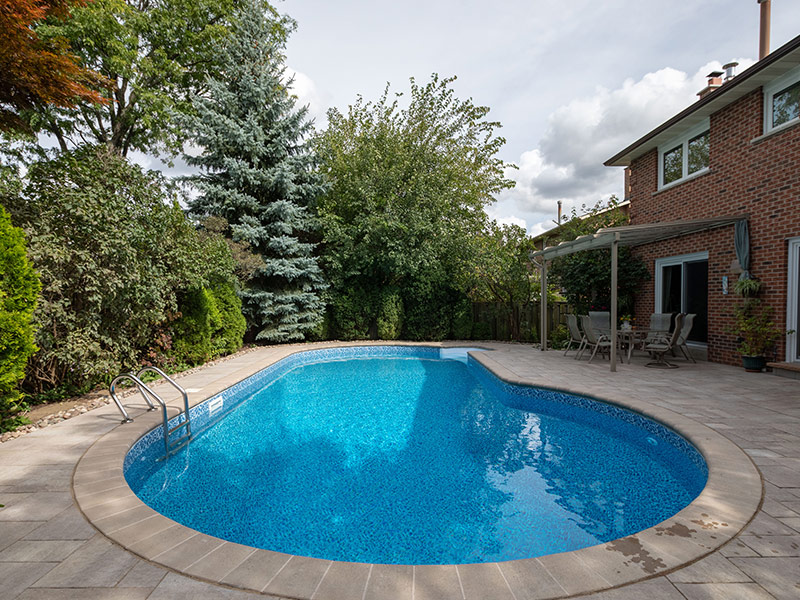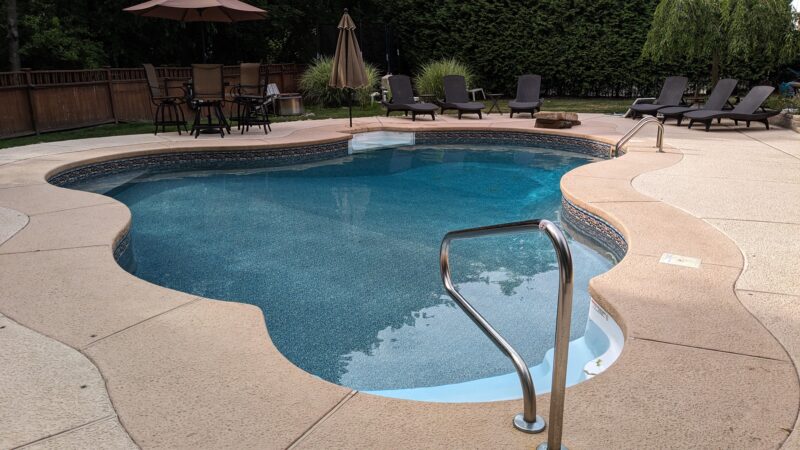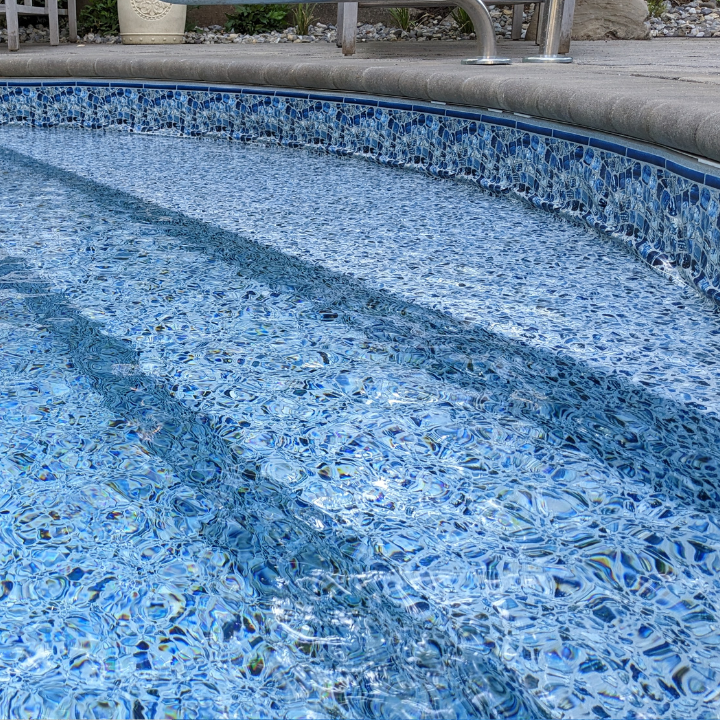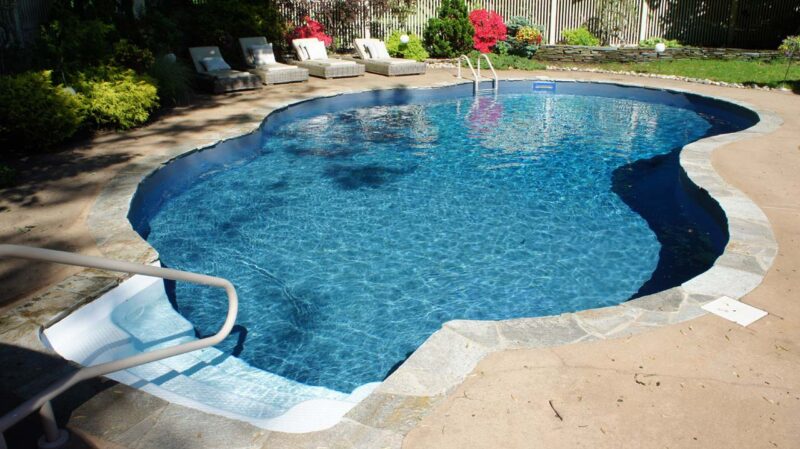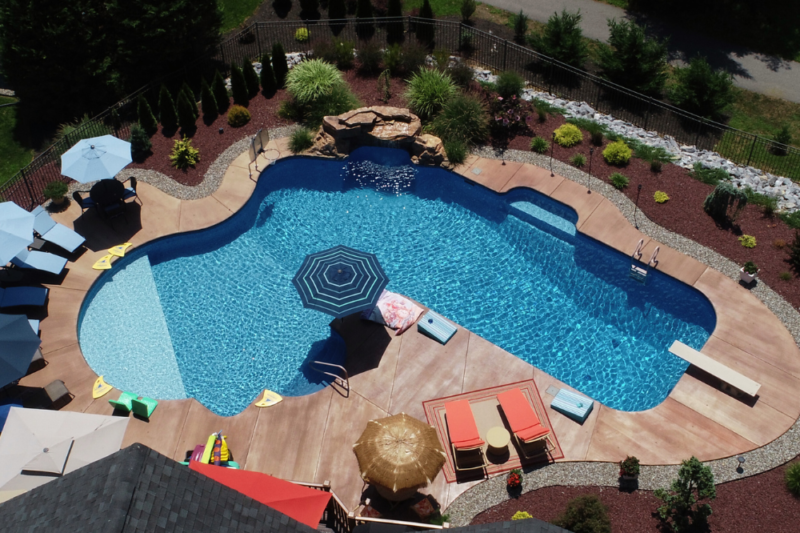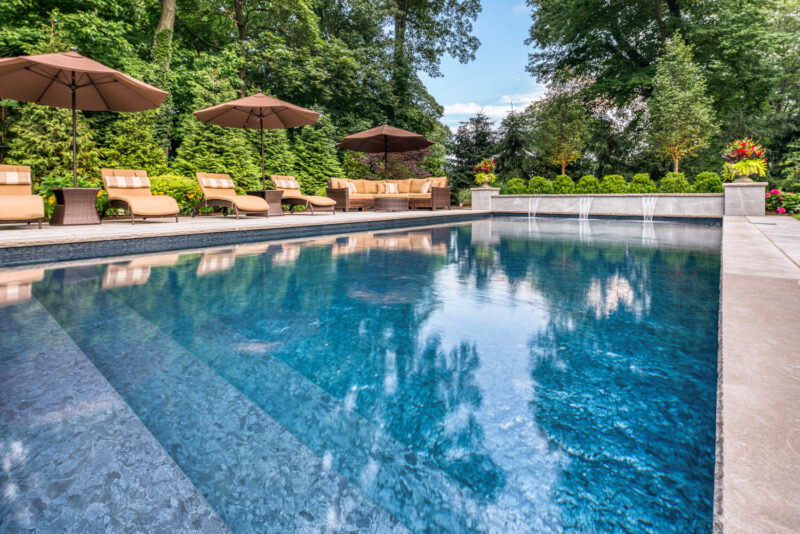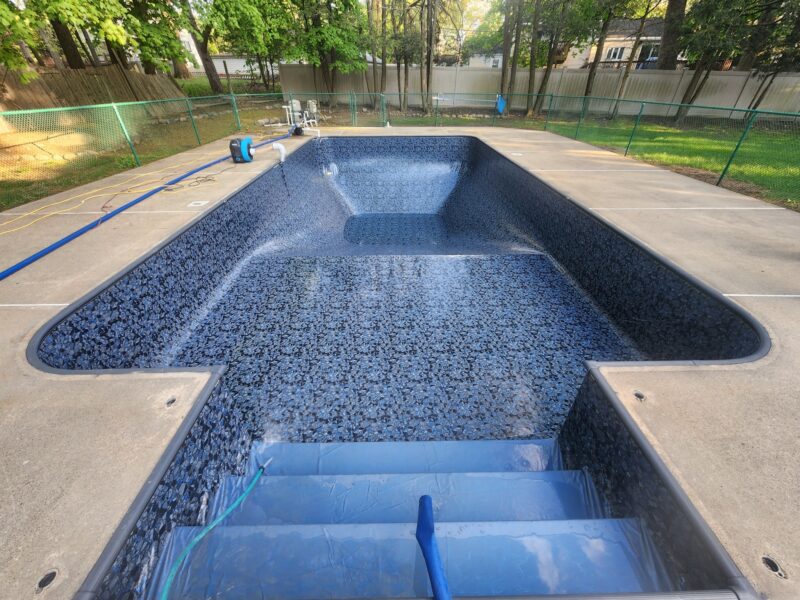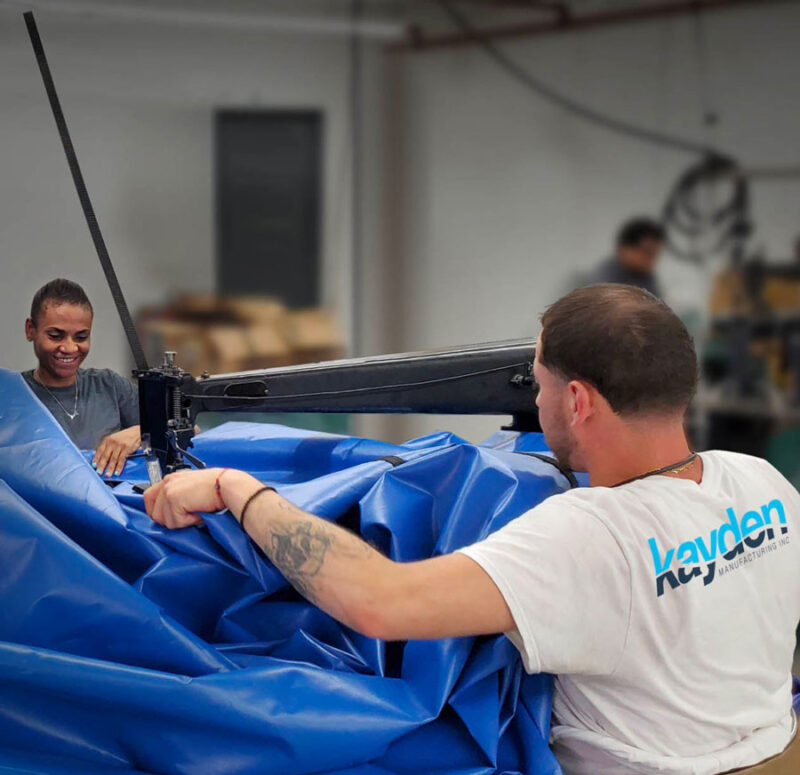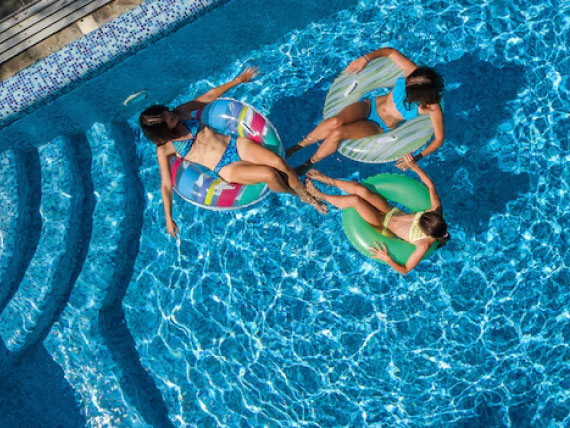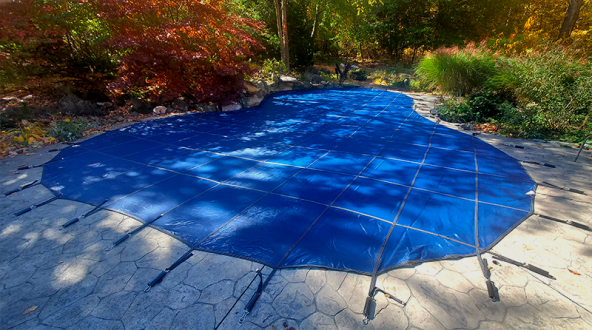Vinyl Liner Pools: Benefits, Cost, Materials, and More (A Guide)
When you think of “vinyl,” what comes to mind? Perhaps, silk, satin, cashmere, or a variety of incredibly decadent materials (and similar difficult words to pronounce) that probably cost a fortune. But, while the phrase “vinyl liner pools” has a word in it that’s as difficult to pronounce as it is to spell, there’s nothing difficult about enjoying these sturdy and long-lasting swimming pools.
In fact, vinyl liner pools are some of the best investments homeowners can make and some of the most lucrative business investments for a swimming pool dealer.
If you’re wondering what in the heck a vinyl liner pool is and how it differs from other types of pools, then you’ve come to the right place.
Kayden Manufacturing here. We’re based out of Paterson, NJ, and are a home-grown vinyl liner and pool safety cover manufacturer that’s been designing and building vinyl liners, pool accessories, steps, water storage units, and industrial solutions for all different types of applications for more than 30 years. And we’re nice people!
If you’re swimming head-deep in pool terminology about vinyl liner pools, and you need a breather and a bit of a primer on all things vinyl liner pools, you’ve come to the right place. In this article, we’ll explore what’s included with vinyl liner pools, including:
- The benefits of owning a vinyl liner pool
- What components are included with a vinyl liner pool
- Costs associated with vinyl liner pools
- A step-by-step breakdown of building a vinyl liner pool
- Frequently asked questions about vinyl liner pools
Join Kayden’s nice people — who make nice pool covers (and accessories) — in this hearty guide all about vinyl pool liners.
Benefits of a vinyl liner pool
Vinyl liner pools are a cost-effective way to enjoy a backyard oasis. Some of the most common benefits of a vinyl liner pool include:
- Lower initial costs to start up a vinyl liner pool
- Quick and seamless construction processes
- The ability to customize your pool’s shape and size
- Smoother pool surfaces
- Do-it-yourself (DIY) options for lining your pool
Most vinyl liner pools are very budget-friendly. You’ll often find vinyl liner pools for $10,000 less than fiberglass or concrete pools.
What’s more, building a vinyl liner pool takes about four to eight weeks, which is much faster than the three to six-month timeline associated with building a concrete pool. And talk about smooth: liner surfaces aren’t as rough as concrete pool surfaces.
Finally, if you want to save money on your next pool build, you can do most of the basic work on your vinyl pool yourself. Of course, a DIY option tends to take longer than with a professional.
What’s more, you run the risk of injury, and the curves of your liner may not have the same precision and fit as that of pool contractors who install pool liners for a living.
Still, the benefits of choosing a vinyl liner can’t be ignored. A vinyl liner pool is a wonderful solution for those looking to spice up their backyard space with relaxing water fun that looks great and won’t break the bank.
What’s included with a vinyl liner pool?
“Yeah, I get that there are benefits to owning a vinyl liner pool. But, what exactly do I get with a vinyl liner pool?” you might be wondering.
When opting for a vinyl liner pool, you’ll have options to customize and add to your existing pool. What’s included with a new vinyl liner pool build is:
- Steps
- Wall panels
- Pool base
- Coping
- A pool’s vinyl liner
Let’s explore what each includes in greater detail.
Pool steps
The three most common types of pool steps used for a vinyl liner pool include:
- White plastic steps
- Vinyl cover steps
- Ladder steps
White plastic steps come standard in vinyl liner inground pools. These steps are made with polymer, attach to a pool’s walls, and stick out from the body of the pool.
Vinyl over steps, on the other hand, are just what they sound like. They are premade steps where you fit — or lay — the vinyl over the pool steps. These steps can be customized with ease.
Ladder steps are, well, just like the ladders you might use to clean your roof, but much smaller. Ladder steps are removable, are installed into the patio near your pool, and hang over the edge of the pool.
Pool wall panels
Wall panels make up the walls of your pool (“Go figure, Kayden.” Hey, we’re doing our best here).
Common materials used on pool wall panels include steel or plastic made from polymer.
Pool base
The pool base provides extra strength for your pool. Its job is to provide a smooth surface for your pool’s liner.
A pool base is usually made with vermiculite or grout, and a pool installer usually applies a mixture of this material on top of the soil. After laying the pool base — often with a pool trowel — your pool installation team installs your liner on top of the pool base.
Coping
Circling the top perimeter of the pool, the coping marks the transition from your pool to your patio.
Pool coping bolts to the top of the pool wall panels. The coping creates a permanent border for the patio concrete. Depending on whether you’re building fiberglass pools or concrete pools, your pool coping will be designed and installed using different methods.
The pool’s vinyl liner
We saved the best for last: the pool’s vinyl liner. The vinyl liner is made of, well, vinyl.
It’s measured in a term we call mils — not to be confused with millimeters. A mil is one one-thousandth of an inch.
You may sometimes hear mil referred to as “thou,” because it’s one-thousandth of an inch.
Most vinyl liners come in 20 and 27 mil thicknesses. At Kayden Manufacturing, we’ve found that 27 works great. This measurement tends to be the sweet spot for a quality, long-lasting liner.
You may also hear another unit of measurement — the gauge — which varies from dealer to dealer.
Liners come in two kinds:
- Embossed liners
- Non-embossed liners (your standard liner)
Embossed liners feel soft because they’re thicker in some parts of the pool than others. Non-embossed liners aren’t quite as squishy because they’re flat on the top of the liner.
And, if you thought thinner liners are more likely to tear, are less expensive, and easier to work with than thicker liners — you’re correct. While thicker liners tend to cost a bit more and are more challenging to work with, they provide extra protection against the elements and tend to last longer.
And you’ll get more life out of your vinyl pool liner with a thicker liner. Think of thicker liners as an investment that pays dividends. By investing in a thicker liner, you’ll have a pool that lasts longer.
Of course, we also understand that choosing the right pool liner can be tough. So, if you ever need help navigating the ins and outs of pool liners, don’t hesitate to give our pool pros a call.
Breaking down the costs of vinyl liner pools
Costs: the elephant in the room. How much do vinyl liner pools cost?
We can better understand vinyl liner pool expenses and pricing by breaking down total pool costs into two categories:
- Initial upfront costs
- Lifetime maintenance costs
Initial costs of a vinyl liner pool
These costs include what you pay when you first buy the pool. Initial costs also include installation costs, costs for new features, and renovation costs to the surrounding area of your pool paradise.
You can think of initial costs as the cost to launch your new pool.
Factors that can influence the initial costs of a vinyl liner pool include:
- Which region your pool is installed in (e.g. arid, humid, cold, or warm climates)
- The size and shape of your pool
- Which pool features you’d like
- The thickness of the pool liner
- Custom steps, coping, and wall panels
- Costs of labor
Lifetime costs of a vinyl liner pool
Lifetime costs include any expenses that contribute to the health and functionality of your pool over its lifetime. Pool insurance, liner replacements, and pool repairs are part of lifetime costs.
Lifetime costs also include the cost of treating your pool with chemicals and heating it with electricity.
Factors that influence the lifetime costs of a vinyl liner pool include:
- Climate
- Natural wear and tear
- Chemical and electricity usage
- Age of the pool (and liner)
- Time of the year you replace your vinyl pool liner
And don’t forget the cost of draining and storing your pool water when it comes time for pool maintenance. Friendly tip: our Pool Bladder can help.
As an aside, the average cost of building a vinyl liner pool can range anywhere from $25,000 to $75,000.
Making vinyl liner pools: materials, processes, and more
When it comes to designing the shape of, constructing the parts for, and installing your new vinyl liner inground pool, the entire process usually takes — on average — about four to eight weeks.
Prospective pool owners: your pool builder will ideally follow and break down the pool-building process into the following steps.
- Step 1: Excavating the space for the vinyl liner (About 1-2 days)
- Step 2: Assembling pool wall panels (About 1 day)
- Step 3: Making time for the concrete footing (About ½ a day)
- Step 4: Plumbing the pool (About 1 day)
- Step 5: Installing the pool base (About 1-2 days)
- Step 6: Installing the vinyl liner (About 1 day)
- Step 7: Finishing the patio (About 1-2 weeks)
- Step 8: Starting up your pool (About 1-2 days)
Of course, if you have add-ons or are installing custom features, you’ll want to budget a little extra time beyond this sample timeline.
Table: Steps 1-8 of vinyl liner pool installations
|
Vinyl Liner Pool Installations Explained |
|
That’s a wrap!
Did you know Kayden is connected to dealers nationwide? With swimming pools expected to grow at a compound annual growth rate of 5.5% until 2030 (DataIntelo, 2024), you couldn’t have picked a better time to find the right pool dealer to line, wrap, and cover your pool.
Speaking of pool dealers, we recently visited the 2024 Atlantic City Pool and Spa Show to showcase the latest trends in pool design, pool liners, safety covers, pool products, and much more to a nationwide network of pool vendors.
Check out all the pool fun here!
Kayden Manufacturing: America’s go-to vinyl liner pool manufacturer
You made it! Thanks for reading this guide all about vinyl liner pools.
We hope you walked away with a better understanding of the benefits, costs, materials, and processes associated with building a vinyl liner pool.
A vinyl liner pool makes for a wonderful addition to an outdoor lifestyle. So long as you’re partnering with a reliable and experienced pool dealer, there’s no reason your new vinyl liner won’t turn out great — and last you for years and years to come.
Speaking of dealers, at Kayden Manufacturing, we’re connected to hundreds of dealers across the United States. We only partner with a network of dealers who work with integrity.
Homeowners: at the end of the day, we’re in the business of helping you build your dream pool. And pool dealers: we’re here to help make your job a little easier in the process.
No corporate nonsense, no switch-and-bait tactics, and no dishonesty. Only expertise, depth of knowledge, and quality customer service.
That’s the Kayden difference. Simply put, we’re nice people making nice liners.
To learn more about how we work with businesses — or to check out our pool products — don’t hesitate to reach out to one of our team members. We’d be happy to help.
Frequently asked questions (FAQ) about vinyl liner pools
What are some benefits of choosing a vinyl liner pool?
Vinyl liner pools are a great choice for the person looking to maximize their backyard experience. Vinyl liner pools provide the following benefits:
- Lower initial costs to start up a vinyl liner pool
- Quick and seamless construction processes
- The ability to customize your pool’s shape and size
- Smoother pool sources
- Do-it-yourself (DIY) options to line your pool
How much does a vinyl liner pool cost?
After factoring in initial costs, costs for maintenance, repairs, liner replacements, and more, vinyl liner pools can cost anywhere from $25,000 to $75,000 depending on your budget, your preferred pool features, and the region of the country where you live.
What’s different about vinyl liner pools from gunite and fiberglass pools?
Vinyl liner pools are different from gunite and fiberglass pools in that vinyl liner pools are often more customizable and affordable than fiberglass and concrete pools.
Concrete pools tend to last longer, and fiberglass pools can be installed faster than vinyl liner pools.
P.S. – So, you actually read through this whole blog. And, we must apologize profusely for how nonsensical it may have seemed at times. But, you’re actually amazing.
You should really click on the link below and talk to us, because we’ll share just what you’re looking for in our time together. Thanks for reading. We just like to keep you on your toes.
More Helpful Content for You
10 Simple Pool Liner Cleaning/Care Tips to Keep Pool Liners Clean
A pool liner can last anywhere from five to 20…
6 Benefits of Being a Kayden Dealer
In the world of pool building and renovation, the products…
A Quick and Comprehensive Guide to How to Clean a Pool Cover
Keeping a pool maintained and serviced is a no-brainer. But,…

